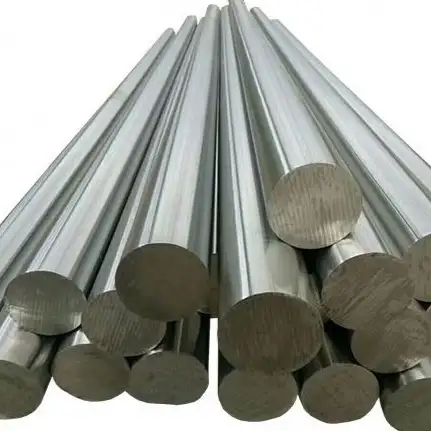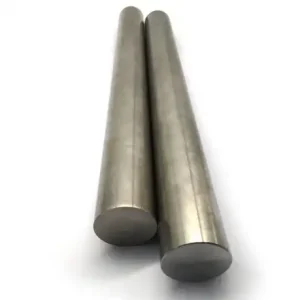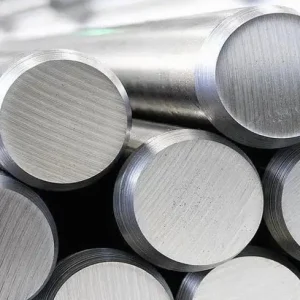Nitronic 50 round bar (trade name Nitronic® 50, UNS S20910, EN 1.3964 / XM-19) is a nitrogen-strengthened austenitic stainless steel that combines significantly higher yield strength than standard 300-series stainless grades with corrosion resistance that equals or surpasses 316/317 in many media. That mix makes it a first-choice material for marine shafting, valve stems, pump shafts, fasteners, down-hole rigging and other components where strength, toughness at low temperature, low magnetic permeability and good corrosion resistance are required. For buyers seeking competitive supply, MWalloys sources factory-priced Nitronic 50 round bar from China with stock inventory and fast cut-to-length delivery.
What is Nitronic 50?
Nitronic alloys are a family of nitrogen-strengthened austenitic stainless steels developed to obtain higher strength and improved corrosion behavior without sacrificing toughness or formability. Nitrogen is intentionally retained in the alloy chemistry to give internal solution strengthening (rather than surface nitriding). Nitronic 50 is the member engineered for a balance between strength and corrosion resistance — it contains elevated chromium, nickel, molybdenum and controlled nitrogen and niobium additions to achieve higher yield strength and pitting resistance while remaining essentially non-magnetic after cold work. Manufacturers and mill datasheets describe Nitronic 50 as offering roughly double the yield strength of common 304/316 grades in typical annealed conditions and specialized high-strength tempers that reach much higher minimum yields for shafting or fasteners.
What is Nitronic 50 round bar used for?
Common component types where Nitronic 50 round bar is chosen:
-
Marine shafting and pump shafts (excellent seawater resistance + strength).
-
Valve stems, actuator shafts and fasteners for aggressive chemical or sour environments.
-
Down-hole and subsea rigging components (good strength at temperature extremes and NACE compatibility when required).
-
Springs, pins and highly stressed machined parts that need both corrosion resistance and higher yield.
-
Components requiring low magnetic permeability (e.g., some sensors, cryogenic service).
The alloy’s ability to maintain toughness at cryogenic temperatures and to remain essentially non-magnetic after cold working makes it versatile for demanding mechanical applications where conventional austenitics would be marginal.
Nitronic 50 Chemical composition
Below is the widely referenced composition window used in supplier and mill product data. Values are weight percent.
| Element | Typical range (wt%) |
|---|---|
| Chromium (Cr) | 20.5 – 23.5 |
| Nickel (Ni) | 11.5 – 13.5 |
| Molybdenum (Mo) | 1.5 – 3.0 |
| Manganese (Mn) | 4.0 – 6.0 |
| Nitrogen (N) | 0.20 – 0.40 |
| Niobium (Nb) | 0.10 – 0.30 |
| Vanadium (V) | 0.10 – 0.30 (in some specs) |
| Silicon (Si) | ≤ 1.0 |
| Carbon (C) | ≤ 0.06 |
| Sulfur (S) | ≤ 0.010 |
| Phosphorus (P) | ≤ 0.04 |
(Source: manufacturer and technical datasheets — these are representative limits; buyers should request mill certificates for exact batch analysis.)
Nitronic 50 Mechanical properties
Suppliers publish properties that depend on temper (annealed, cold-worked, high-strength variants). Below are common, conservative reference values for annealed Nitronic 50 round bar and notes about high-strength tempers.
| Property | Typical (annealed) | Notes |
|---|---|---|
| Yield strength (0.2% offset) | ~380 MPa (≈55 ksi) | Typical annealed condition; HS tempers available with ≥105 ksi yield. |
| Ultimate tensile strength | ~690–806 MPa (100–117 ksi) | Supplier values vary by sample size and cold work. |
| Elongation (A%) | ~35% | Good ductility for fabrication. |
| Hardness (HRB or HRC equiv.) | ~<300 HV (variable) | Depends on temper; cold worked grades are harder. |
| Density | ~7.88 g/cm³ | Typical stainless density. |
| Operating temperature | Good −200°C up to ~650°C | Maintains toughness at sub-zero and retains strength at elevated temperatures; check supplier limits for continuous service. |
Interpretation for designers: Nitronic 50 gives designers the chance to reduce section size or improve factor of safety because the yield often exceeds conventional austenitics by a large margin. High-strength Nitronic 50 variants (HS, Super HS) can be specified for shafts and fasteners requiring very high yield values; always confirm which temper the supplier is shipping and review guaranteed minimums in the mill test certificate.
Nitronic 50 Specifications, product forms and round-bar details
Standards and cross-references: UNS S20910; EN 1.3964; XM-19; ASTM/AMS references appear for particular product forms (e.g., AMS 5764 for certain forms). Nitronic® is a registered trademark originally held by Armco/AK Steel and now under Cleveland-Cliffs / Electralloy licensing for certain products.
Common round-bar forms: hot-rolled, peeled/turn-finished, bright-drawn, peeled & turned to tight tolerances. Typical stocked diameters range from small metric sizes (6–10 mm) up to large shafts (100 mm+), with custom lengths and bar-end machining available.
Typical tolerances / finishes:
-
Hot-rolled: broader diameter tolerance, economical.
-
Peeled/turned: tighter roundness and surface finish, preferred for shafting and precision components.
-
Certificates & testing: request EN 10204 3.1/3.2 or equivalent, chemical analysis and mechanical test reports.
Suppliers often offer HS (high strength) and SHS/UHS variants with guaranteed minimum yields for critical service. Specify temper and mechanical property minima on the PO.
Fabrication notes (machining, welding, heat treatment)
Machining: Nitronic 50 machines somewhat more slowly than Type 316; higher feeds and lower speeds and robust tooling are recommended for heavy cuts. Use sharp carbide tooling; chip evacuation and rigid fixturing improve surface finish. Pre-turning allowances for tight tolerances are common when using hot-rolled bars.
Welding: Conventional austenitic filler metals work well; matching filler with sufficient nickel and molybdenum is recommended in aggressive environments. Post-weld annealing can improve corrosion resistance in heavily stressed or thick weldments; many applications use the 1950–2050 °F anneal ranges recommended by mill datasheets to optimize corrosion resistance.
Heat treatment: Solution anneal typically in the range 1066–1121 °C (1950–2050 °F) followed by rapid quench. For most applications, anneal at the lower end to keep strength; for severe corrosion environments or as-welded service, specify the higher anneal temperature to minimize intergranular attack risk. Cold working increases strength and may be used to create HS tempers.
Corrosion performance and comparison to 316/317
Nitrogen and added molybdenum give Nitronic 50 superior pitting and crevice corrosion resistance relative to 316 and often comparable or better than 317L under many conditions. In chloride-rich or sea water services it typically outperforms 316; however, severe chloride stress-corrosion cracking remains a concern across many austenitics, and Nitronic 50 should be tested or qualified for critical SSC (stress corrosion cracking) service or sour environments per NACE when required. For many pump, valve and marine components, Nitronic 50 delivers a practical balance of corrosion resistance and strength that reduces size or weight while improving service life.
Global price snapshot — 2025 (indicative ranges)
Important: stainless alloy pricing depends strongly on quantity, form, diameter, temper, global nickel/molybdenum markets and freight. The table below gives indicative retail and mill-level ranges collected from distributors and Chinese suppliers in 2025. Use these as procurement starting points; request formal quotes for specific sizes, tempers and MTRs.
| Source / market | Typical 2025 indicative range (per kg) | Notes / sources |
|---|---|---|
| Chinese manufacturers / B2B portals | US$20 – US$38 / kg | Small MOQ offers shown on manufacturing marketplaces (Made-in-China listings). |
| US distributors / cut-to-length retail | US$25 – US$90 / kg (higher for small cut pieces) | Online retail prices for short bars / small diameters typically show higher per-kg rates; volume discounts apply for full bars. |
| European suppliers / mills | €18 – €60 / kg (approx.) | Depends on finish (peeled/turned), certification and delivery lane. |
| Bulk mill / tonne (industrial orders) | US$1,500 – US$3,000 / tonne | Large volume negotiated pricing; published per-tonne ranges reported by specialized alloy suppliers. |
Sourcing advice — why choose MWalloys
MWalloys is set up to serve engineering buyers who require traceable Nitronic 50 round bar at factory pricing and with stocked delivery capability from China. Key procurement advantages we provide:
-
Factory (mill) channel: direct factory sourcing reduces middle-man markup so buyers get a more competitive net price.
-
Stock inventory: standard diameters available for fast cut-to-length turnaround and export packing.
-
Documentation: every shipment includes MTR/chemical and mechanical certificates; higher-value orders can include 3.2/3.1 inspection paperwork.
-
Customization: peeled/turned finishes, special HS tempers, and accepted third-party inspection on request.
-
Export experience: packing, customs paperwork and global logistics supported for common trade lanes.
If you need an immediate quote for specific diameters, lengths and tempers, MWalloys’ sales team can provide a formal offer with mill certificates and lead-time commitments. (Statement of capability — sample commercial terms will be included on quotes.)
Note to engineers and buyers: always specify temper (annealed vs HS), required certification level (e.g., EN 10204 3.1/3.2), heat number traceability and any NACE/ISO requirement on the purchase order.
Procurement and inspection checklist
-
Specify UNS S20910 (or Nitronic® 50) and temper (annealed / HS / SHS).
-
Request chemical and mechanical MTR per heat (EN 10204 3.1/3.2).
-
Confirm surface finish: hot-rolled, peeled, peeled & turned (as required).
-
If for oil & gas or sour service, confirm NACE MR0175 / ISO 15156 compatibility.
-
Ask for sample hardness and tensile/yield test values for the shipped lot.
-
Inspect bar ends for heat number stamping, straightness and dimensional tolerance on receipt.
-
For critical items, use third-party inspection and witness tests at the mill.
-
Keep a spare batch for future matching (metal lot variability can exist).
Frequently asked questions
-
Is Nitronic 50 magnetic?
Normally it is essentially non-magnetic, and it retains low magnetic permeability even after heavy cold work or exposure to cryogenic temperatures. -
Can Nitronic 50 replace 316 for shafts?
Yes — in many cases Nitronic 50 offers superior corrosion resistance and ~2× yield strength versus 316, enabling smaller sections or longer life for shafts and pump components. Confirm chloride SCC requirements before final selection. -
What tempers are available for round bar?
Annealed is common; HS (High Strength) and higher cold-worked tempers (Super HS) are available for higher minimum yield guarantees. Ask the supplier for guaranteed minima. -
Is Nitronic 50 weldable?
Yes. Standard austenitic welding practices apply. Use appropriate filler metal and consider post-weld anneal for severe corrosion service. -
What is the UNS/EN number?
UNS S20910, EN 1.3964 (also referenced as XM-19 in some specs). -
How does Nitrogen help the alloy?
Nitrogen increases yield strength and pitting resistance without sacrificing toughness, by solution strengthening the austenitic matrix. -
Can it be used in sour oil & gas service?
Nitronic 50 is used in many oil & gas applications but NACE/ISO qualification must be confirmed for each heat and application. Ask for NACE documentation and hydrogen sulphide testing if required. -
What inspection documents should I insist on?
MTR (chemical + mechanical), EN 10204 3.1/3.2 or equivalent, heat number traceability and any NACE or customer-specific test reports. -
Are there size limits for HS tempers?
Yes — some high-strength and ultra-high-strength tempers are available only in limited diameters or forms. Confirm availability with the mill. -
Is Nitronic 50 suitable for cryogenic use?
Yes; Nitronic 50 retains toughness at sub-zero temperatures and is used in cryogenic and low-temperature engineering applications.





